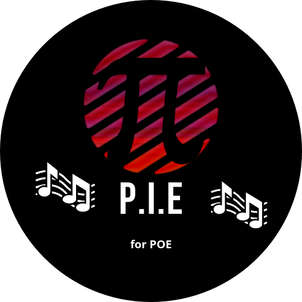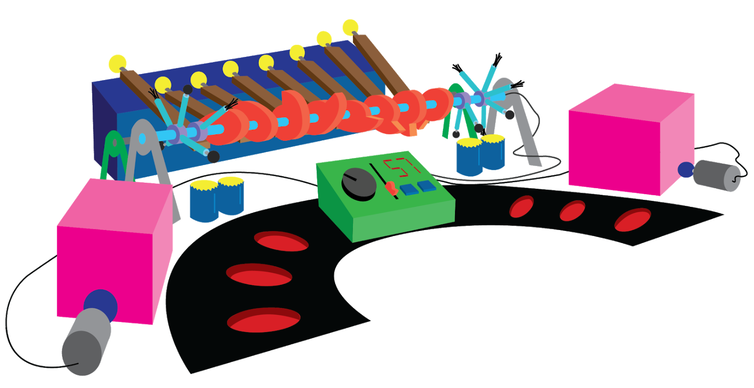Where We Started
When discussing our goals in the first team meeting we eventually ended up agreeing on a couple of things. Our group wanted to create something feasible and was interested in music. So we made a list of our goals.
+ Centered around music
+ Mechanically detailed
+ Large and interactive
- Not autonomous
- Not all-or-nothing
Making this project interactive was a very important part of our design. We hoped that a first time user would be confused and amused at the same time when playing the instrument. We wanted to be unconventional with the way we created this. The P.I.E. stands for performance immersive experience.
"We hope to engineer an intricate experience that allows users to create a host of unusual sounds, even simultaneously."
We did not want it to be portable. We believed that it was going to be large with full of appealing physical parts that made incredible sounds. We hoped to make it have some quasi steampunk aesthetic so people could admire the complexity behind this odd musical instrument.
+ Centered around music
+ Mechanically detailed
+ Large and interactive
- Not autonomous
- Not all-or-nothing
Making this project interactive was a very important part of our design. We hoped that a first time user would be confused and amused at the same time when playing the instrument. We wanted to be unconventional with the way we created this. The P.I.E. stands for performance immersive experience.
"We hope to engineer an intricate experience that allows users to create a host of unusual sounds, even simultaneously."
We did not want it to be portable. We believed that it was going to be large with full of appealing physical parts that made incredible sounds. We hoped to make it have some quasi steampunk aesthetic so people could admire the complexity behind this odd musical instrument.
First Draft
From the start of the project we decided that the most efficient and effective way for us to create our own musical instrument was to delegate work. Therefore, we split the instrument into three components: mechanical rhythm, programmable rhythm, and electrical melody.
|
the mechanical rhythm mainly consisted of camshafts hitting drumsticks that hit a density customizable box and spinning arms that also hit the same box.
|
by using two solenoids to hit drums we wanted the user to be able to loop a certain rhythm that they created |
with a large range of sensors the electrical melody was modeled to be played similarly like a theremin with more possibilities. |
|
|
Electrical MelodyWhen first trying to play music with the Arduino we had some issues. The sounds coming out of it were customizable but very electronic and rough. Our first play test was deafening but at last we were able to play a subpar version of hot cross buns. We only used three infrared sensors that each only ranged two octaves. The sensors also seemed to have issues as they were not so precise.
|
Solenoid DrumsOur initial prototype of the solenoid drums did not have a looping functionality. We just wanted to be able to prove that the solenoids could create a good enough rhythm to be played along the mechanical component. A problem we had was that some solenoids were not strong enough to create loud sounds. Power also seemed to be an issue as we had to use an external power supply for some of the larger solenoids.
|
|
|
|
Spinning ArmsWhen working on the mechanical rhythm we wanted the spinning arms and drumsticks to compliment each other. However, after creating a prototype for the spinning arms we figured out that the sounds it creates are not loud enough to work well with the rest of the instrument. Our first design for the drumsticks component was with a single camshaft. After hearing how strong the sound it created was we decided to pursue creating a more intricate camshaft system.
|
What did we learn?
From our initial tests in Sprint 1 we learned that the camshafts with drumsticks were crucial in creating a proper mechanical rhythm. While the electrical melody did play what could be considered music, we wanted it to play in a more proper harmony. Thus, we learned to start looking for different alternatives than Arduino for the melodic component. As for the programmable rhythm, we learned that it was necessary to integrate it with some sort of looping functionality.
After going through the responses from our feedback document we learned that many people were confused about what the P.I.E. was meant to be. While we did want the instrument to be somewhat complex, the ambiguity from our peers was certainly an issue. Still, people seemed to really like the concept of creating a unique musical instrument. Based on the responses and from our own ideas we created our goals for Sprint 2.
Implement looping solenoid drums with Arduino code
Make more advanced prototypes for spinning drums
Match tempos of solenoid drums and spinning drums
Clearly define what we want our melody part to do
We wanted to be able to clearly define what sort of instrument the P.I.E. was going to be in all of its components by Sprint 2. Its also important that we wanted the individual parts to work well with each other.
After going through the responses from our feedback document we learned that many people were confused about what the P.I.E. was meant to be. While we did want the instrument to be somewhat complex, the ambiguity from our peers was certainly an issue. Still, people seemed to really like the concept of creating a unique musical instrument. Based on the responses and from our own ideas we created our goals for Sprint 2.
Implement looping solenoid drums with Arduino code
Make more advanced prototypes for spinning drums
Match tempos of solenoid drums and spinning drums
Clearly define what we want our melody part to do
We wanted to be able to clearly define what sort of instrument the P.I.E. was going to be in all of its components by Sprint 2. Its also important that we wanted the individual parts to work well with each other.





